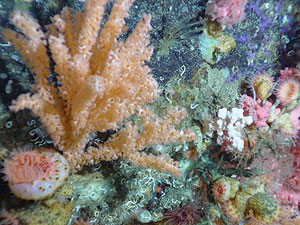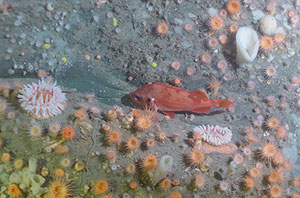 |
The ROPOS camera provides a glimpse of the sea bottom of the Northeast Channel, replete with corals, anemones and sponges. |
Ever notice that those little blue kitchen scrubbers, like socks in the dryer, always seem to go missing?
Which makes it all the more remarkable that scientific researchers aboard the Coast Guard ship Hudson were able to find them four years after placing them on the ocean bottom in the 424-square-kilometre Coral Conservation Area in the Northeast Channel.
They’re used as part of “larval settlement collectors,” designed to see what organisms are attaching and surviving on the ocean floor after the area was closed to fishing in 2002.
The area, about 100 nautical miles off southwestern Nova Scotia, is home to up to 35 species of deep-water coral, such as bubblegum coral and seacorn coral. Prior to the area being closed, one could find broken and tilted corals and scattered skeletons – signs of fishing impacts on the long-lived corals.
“This area was fished heavily,” explains Anna Metaxas, professor with Dalhousie’s Department of Oceanography, on shore in Shelburne, N.S. where the Hudson was having a crew change. “We were concerned about corals recruiting into the area. Habitat that is suitable for the tree-like deep water corals is rare. Plus, they’re so beautiful -- in pink, orange, white, red and yellow. You can’t believe how incredible it is 600, 800 metres below the surface.”
 |
| This photo from Jordan Basin shows a red fish, large and small anemones and sponges. |
The Hudson is equipped with a ROPOS (remotely operated deep water submersible), a Volkswagen-sized underwater robot equipped with GPS, high-definition video and digital cameras and two robotic arms which allow it to take samples. The sophisticated equipment was able to re-locate the larval settlement collectors to within a metre of where they were placed in 2006 and retrieve them.
“Those blue scrubbers are full of little holes that organisms like to hide in ... It was very exciting to see them again,” says Dr. Metaxas, her voice animated. As a benthic ecologist, she’s interested in the factors that regulate populations of marine invertebrates, particularly in their early life stages. “They were absolutely full of things. You can see baby corals, scallops, brittle stars, anemones...”
The scientific expedition, with 28 science staff, 6 ROPOS crew and 33 Canadian Coast Guard crew aboard, left the Bedford Institute of Oceanography in Dartmouth on July 29 and is expected back August 11. The two-week cruise is part of a collaborative NSERC project called the Canadian Healthy Oceans Network (CHONe) and includes students, geologists, and oceanographers from Dalhousie, University of Victoria, Memorial University of Newfoundland, Laval, as well as their collaborators from Fisheries and Oceans Canada. Among the Dalhousie contingent is Dr. Metaxas, MSc student Myriam Lacharite and NSERC USRA Jessie Short.
Besides the Northeast Channel, the cruise investigated four other study areas at depths up to 3,000 metres: Jordan Basin, German Bank and Northeast Fan. As well, seabird and marine mammal surveys took place from the bridge during daylight hours.
“For me, it’s really neat to watch the students,” says Dr. Metaxas. “The deep sea is a pretty special place and one does not expect it to be so because it’s so dark and remote. So when you can see what’s here, well, it’s pretty amazing.”
LINKS: Blog from the Hudson, http://hudson0302010.blogspot.com | Canadian Healthy Oceans Network (CHONe)
